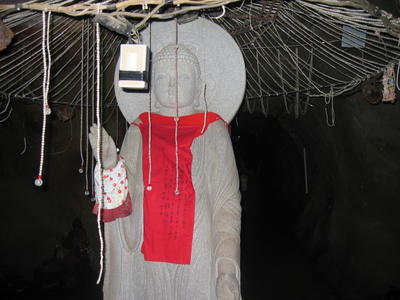Dougo
There is a town-within-a-city in Matsuyama called Dougo. Yet another onsen town, its claim to fame is the Dougo Onsen Honkan, the oldest hot springs in Japan. It is especially well known for being the setting for Natsume Souseki's 1906 novel "Botchan," reputably the most widely read novel in the country. Of course I had to be a tourist and read my copy along the way. Not that I'm not a tourist just because I "live" in Japan.
The onsen appears in the earliest surviving history of Japan, dating from the 8th century. Despite its nominal significance, the bath itself wasn't particularly enticing. The main onsen only contains one medium-sized pool; most contain a few, as well as saunas, hot showers, (near freezing) cold tubs, and scalding hot high-pressure showers.

A bust of Natsume Souseki is featured in the room Botchan used when he visited the onsen--whatever it means for a novel's protagonist to visit a really existing place.

After the onsen, I ventured to Isaniwa Shrine, dedicated to Hachiman, the god of war. This mid-17th century shrine sits at the top of 140 stone stairs.




From there, I headed to the highlight of Dougo (in my humble opinion), Ishite-ji. The main temple complex houses a number of structures--some dating from as early as 1318--and is one of the most sacred temples on the 88 temple circuit (see the next post for more information). The name--"stone hand temple"--derives from a story involving Buddhist demigod Kooboo Daishi.





I know, I know, just another temple. But let me finish. The best part of Ishite-ji is that the temple invests its revenue in a special form of religious expression; let's call it "surrealo-Buddhism." Behind one the temple buildings adjacent to a mountain is a cave entrance artificially sculpted into the stone. What ensues is right out of a Herzog movie.

Once inside, the hallway is almost pitch-black. You can make out a row of stone Buddhas lining the walls, but anything away from the entrance might as well be invisible. I used my flash for the second photo to give you an idea of what the hall contains.


There are a few occasional bizarre relics placed around the floor amidst puddles of accumulated water from the constantly dripping ceiling. An example, below. It sort of reminds me of that evil kid (Ned?) in "Toy Story."

After a number of twists and turns, I could make out some flashing lights in the distance, which turned out to be strobe lights. I also heard some strange wails, which turned out to be emitted by a speaker duct-taped to a large Buddha in the chamber ahead.

My "Rough Guide to Japan" describes the atmosphere of this room as one that "create[s] the impression that you've stumbled into an esoteric rave." Of course I couldn't capture the strobe lights on film (or Compact Flash card, rather), but I did manage to get some of the statues and hanging beads under the red light.


It only gets stranger. After another long, dark Buddha-lined hallway, I saw the light of day. After exiting the cave, I realized I was on some rural highway called "Route 26."

Across the highway to my left was a fat smiling Buddha...

...and a gargantuan demonic statue perched atop a gate.

Entering this gate, I followed a path lined with painted statues, peeling from age.

Ahead, I could see a giant gold sphere surrounded by yet more odd statues. Feral cats and roosters marched around the entrance, seemingly leaving each other alone.


Just to the right of the entrance sat a malnourished, Christ-like ascetic, deep in prayer.

I followed the short staircase into the globe to find about two hundred wooden statues arranged around the periphery.




After I left the globe, I decided to see what lay further down the road. Retracing my steps, I passed some notable statues, as well as a bizarre cobweb-covered shrine decorated with upside down umbrellas.


As I proceeded, I noticed a towering statue of Kooboo Daishi atop a mountain close to the road. I walked to the mountain, which turned out to be Ishite-ji's graveyard. There are many stairways up the mountain, but each ends in a random spot, only to lead to another stairway. After twenty minutes or so of navigating this labyrinth, I gave up, and headed down.


Finally, I retraced my steps through the cave and left the temple.




















